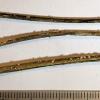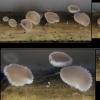
19-11-2025 23:21
 carl van den broeck
carl van den broeck
Dear guestIn Waardamme, Belgium, I found dozens of

19-11-2025 20:51
 Andreas Millinger
Andreas Millinger
Good evening,found this species on a felled trunk

19-11-2025 13:04
 Bruno Coué
Bruno Coué
Bonjour,je sollicite votre avis pour la récote

17-11-2025 21:46
Philippe PELLICIERBonjour,Récolté sur bois pourrissant de feuillu

16-11-2025 21:09
 Robin Isaksson
Robin Isaksson
Anyone recognize this acc. to pictures.? Found on

18-11-2025 13:59
Nogueira HéctorNovember 14, 2025 Brazuelo (León) SPAIN Hymenosc

17-11-2025 19:14
herman lambertApothécie discoïde 0.6 cm diam., orangeFace hym�

17-11-2025 21:57
Philippe PELLICIERBonjour,Récolté sur bois de feuillu mort dur, no

14-11-2025 16:26
 Marian Jagers
Marian Jagers
Hello everyone, On dead wood of Cytisus scoparius
• Using Baral's key, subkey 3: No crystals, VBs, croziers, hair apices uninflated.
• Of these species on grasses, L. tenuipilosum seems to be the best fit.
• Some characters fit better with L. 'longipilosum' in the key, but perhaps these have been combined now.
Habitat: Apparently widespread (micro only on one collection) on dead stems and sheaths of Ammophila arenariain, standing or fallen, both on the inside and outside of the sheaths, in damp places under cover of living plants, on sand dunes, both sides (sea and land), on a beach, river mouth nearby, West Beach, Angmering, south England, 26/11/24.
Apothecia: Diameter < 1 mm, gregarious to 2-caespitose, apparently superficial, yellowish to pinkish disc, sometimes more vinaceous-purplish - possibly when overmature or injured, some with a noticeable stipe, short white hairs.
Macro: Cupulate to discoid, shallow, narrow-cylindrical stipe, often short to substipitate, short white hairs on receptacle and margin, agglutinated in groups, protruding above the disc until maturity, disc initially pale yellow, becoming more buff to reddish-brown, eventually more convex, faintly pruinose appearance (paraphyses), no sign of a subiculum or disturbance to the substrate.
Asci: Turgid ~45-60 x 5.5-6 um, croziers, rings mostly bb, occasionally more dirty and once rb, Calycina-type?, 2-4-seriate, thickening appears noticeably shallow when flaccid.
Spores: Cylindrical-allantoid or longer and more fusiform, ~2-6 tiny shadowy LBs towards each pole, OCI ~0.5, ends +/- tapering to acute-rounded, approximately homopolar but sometimes base more elongated, inequilateral to very slightly curved in profile view, flexible, becoming narrower and appearing empty when dead.
Free living spores in water:
(9.0) 9.8-14.2 (16.5) × 1.6-2.1 (2.3) µm, Q = (4.9) 5.2 - 7.9 (8.3), N = 26, mean = 11.7 × 1.9 µm, Q mean = 6.3.
Paraphyses: Broadly lanceolate, width ~5-6.5 um, tapering to blunt apex, more pointed when dead, protruding considerably above mature asci ~20-25 um, filled with many tiny VBs, medium density, 1-2 septate, apical cell ~2-4x longer, possibly with an SCB – more noticeable in IKI.
Hairs: 60-80+ um long, cylindrical, apex rounded, aseptate, apically with tiny amorphous warts, with VBs similar to paraphyses, sometimes no VBs at apex.
Medullary: Text. porrecta.
Ectal: Text. prismatica-angularis, hyaline, more angularis towards the base?
Exudate: Peachy-yellowish, around the hair apices and in the excipulum.

The lack of (large) VBs in the fresher paraphyses is noticeable compared to some photos, but I think you are correct. It is interesting that the VBs in the hairs then appear more stable, and this could be related to the disc changing colour with maturity.





 Hymenium-0032.jpeg
Hymenium-0032.jpeg